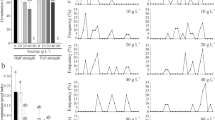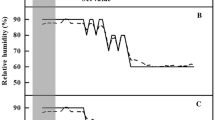Abstract
Shoot cultures of Echinacea × Sombrero® “Salsa Red” were rooted in vitro in rigid and flexible film vented vessels, in agar-gelled medium, and in phenolic foam plugs (Oasis® InVitro Express [IVE]). Rooted plants were acclimatized to greenhouse conditions in a peat-based, soilless medium or in a larger cellular plug (Oasis® Rootcubes® Wedge®). The size of the plants leaving the laboratory, the speed of planting in greenhouse medium, and plant growth in greenhouse medium were influenced by both the laboratory and greenhouse media in which they were grown. The largest plants leaving the laboratory were from agar medium. The speed of deflasking and medium removal was greatly improved with IVE replacing agar in laboratory vessels. Planting in the Oasis® Rootcubes® Wedge® allowed a further reduction in planting time compared to planting in peat-based medium. In the greenhouse, plants in IVE/Oasis® Rootcubes® Wedge® grew more quickly and had more leaves of better quality than those from agar, planted in peat-based medium. However, the best plants (based on number of leaves, leaf length, and plug quality) in the greenhouse were from IVE, planted in peat-based medium, a treatment that still required less planting time than agar-based medium. Pre-hardening of in vitro-rooted plantlets using vessel systems that allow for ventilation and easily transferred root systems showed superior greenhouse growth simultaneous with improvements in the efficiency of workers that handled the plants. This is the direct impact of vessel systems and matrix purposefully designed to facilitate this stage of growth.





Similar content being viewed by others
References
Adelberg J (2016) Micropropagation in liquid culture using partial immersion systems. Acta Hortic 1113:35–46
Adelberg J (2017) Bioreactors and “smart vessels” for large scale propagation. Acta Hortic (in press)
Adelberg J, Naylor-Adelberg J, Rapaka V (2015) A novel rooting matrix and vessel system resulted in larger plants and faster growth during greenhouse acclimatization of Hydrangea quercifolia ‘Sikes Dwarf’. Propag Ornam Plants 15:89–94
American Herbal Pharmacopoeia: Botanical Pharmacognosy - Microscopic Characterization of Botanical Medicines (2006) Upton R, Graft A, Jalliffe G, Langer R, Williamson E (eds), CRC Press, Taylor and Francis Group, Boca Raton, FL pp 350–373
Bruneton J (1999) Pharmacognosy: phytochemistry of medicinal plants. Lavosier Publishing, Paris, pp 173–176
Economou AS (2013) From microcutting to microplant establishment: key points to consider for maximum success in woody plants. Acta Hortic 988:43–56
Harbage JF (2001) Micropropagation of Echninacea angustifolia, E pallida, and E. purpurea from stem and seed explants. Hortscience 36:360–364
Lata HE, Moraes BRH, Adndrade Z (2004) Mass propagagation of Enchinacea agustifolia: a protocol refinement using shoot encapsulation and temporary immersion liquid system. Acta Hortic 629:409–414
Murashige T, Skoog F (1962) A revised medium for rapid growth and bioassays with tobacco tissue cultures. Physiol Plant 15:473–497
Naylor Adelberg JA, Adelberg JW, Rapaka VK (2016) A rooting matrix and tissue culture vessel system yielded larger, faster growing Echeveria plants. Acta Hortic 1113:53–58
Zobayed SMA, Saxena PK (2003) In vitro regeneration of Echinacea purpurea L: enhancement of somatic embryogenesis by indolebutyric acid and dark pre-incubation. In Vitro Cell Dev Biol Plant 39:605–612
Acknowledgements
This work at Clemson University was supported by a grant from the Smithers-Oasis Co. The use of trade names does not imply product endorsements by Clemson University or its employees.
Author information
Authors and Affiliations
Corresponding author
Additional information
Editor: Jessica Rupp
Rights and permissions
About this article
Cite this article
Adelberg, J., Naylor-Adelberg, J. & Rapaka, V. Phenolic foam rooting matrices allows faster transfer and more rapid growth of Echinacea plants in greenhouse. In Vitro Cell.Dev.Biol.-Plant 53, 546–552 (2017). https://doi.org/10.1007/s11627-017-9843-4
Received:
Accepted:
Published:
Issue Date:
DOI: https://doi.org/10.1007/s11627-017-9843-4




